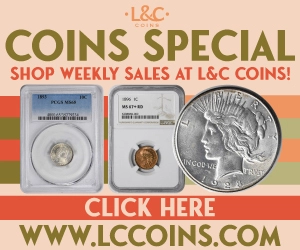By Victor Bozarth for PCGS ……
Part 1 | Part 2 | Part 3 | Part 4
* * *
How can we, as denizens of the 21st century, even fathom how an individual in 1915 would react to the show produced by the Tower of Jewels at the Panama-Pacific Exposition in San Francisco once night had fallen? For those at the event honoring the completion of the Panama Canal, it had to have been both euphoric and mesmerizing!
On a sunny day, the Tower of Jewels was a sight to behold, with over 100,000 crystals–called Novagems–hung in front of mirrors on the massive 435-foot structure. These Novagems came in eight vibrant colors and reflected sunlight, which produced the colors of the rainbow. During the day, it was mesmerizing.
In the dark of the evening, the true wonder of the Tower of Jewels became evident. Designed to be illuminated by the Electric Scintillator, the Tower of Jewels at night was further illuminated by a massive searchlight battery (mounted on the breakwaters of Yacht Harbor). Fifty giant spotlights operated by a company of the United States Marine Corps focused their beams using precise timing to maximize the color and scope on the facets of the 100,000-plus Novagems!
Amazing color in a kaleidoscopic broadcast would have been a life-changing experience for the time. I would argue that the Tower of Jewels was the first true “light show” of the 20th century.
OK, I’ve set the stage. The fairgrounds themselves boasted 11 palaces and 240 other buildings to create the “City of Domes”, using color liberally, which was enhanced by the illumination of the Tower of Jewels. More than 300,000 cubic yards of fill were used to create land for the fair. These fairgrounds, now the Marina District, were a 635-acre area extending 2.5 miles along the bay, forming a natural amphitheater facing the Golden Gate.
The big achievements commercially at the fair in 1915 were the transcontinental telephone call, wireless telegraphy, and widespread endorsement of the automobile. Yes, I may consider myself a dinosaur in these times, but my mind goes to cell phones, wireless internet in our homes, and electric vehicles. How can we relate, indeed?
We as numismatists can relate to the fair by way of one of its most famous sculptures, The End of the Trail – sculpted by James Earle Fraser. The designer of the United States Buffalo Nickel, Fraser first conceived The End of the Trail while studying at the Chicago Art Institute. The colossal piece he sculpted from plaster of Paris for the 1915 Exposition won a gold medal for sculpture. The 1915 Panama-Pacific Exposition also inspired five of the most well-known coins of the classic commemorative era. We will delve into these five most gorgeous coins, including the challenges of producing and the joys of collecting them, in the next two installments.
* * *
References
Bowers, Q. David. Commemorative Coins of the United States: A Complete Encyclopedia. Bowers and Merena Galleries, Inc. (1992)
Burdette, Roger W. Renaissance of American Coinage, 1909-1915. Seneca Mills Press (2007)
Swiatek, Anthony and Walter Breen. The Encyclopedia of United States Silver and Gold Commemorative Coins, 1892-1954. Arco Publishing (1981)
www.nps.gov/prsf/learn/historyculture/1915-panama-pacific-international-exposition.htm
Panamapacificinternationalexposition.com
* * *
About the Author
Vic Bozarth is a Professional Numismatics Guild (PNG) member (#661). Both Vic and Sherri Bozarth are members of the ANA, FUN, CSNS, and many other regional and state coin clubs and organizations. Vic has had extensive experience both buying and selling coins into the mid-six-figure range. Both Vic and Sherri attend all major U.S. coin shows, as well as most of the larger regional shows.
* * *
